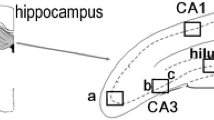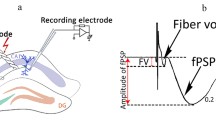Abstract
Animal models of seizures and epilepsy are very diverse and instrumental for elucidating the mechanisms that underlie convulsive states and epileptogenesis. A single injection of pentylenetetrazole (PTZ) induces seizures, however, does not raise the risk of further development of epilepsy. Pilocarpine, immediately after injection, evokes epileptical state and, following a latent period, results in the development of spontaneous seizures, i.e. the drug triggers epileptogenesis. Assuming that in the PTZ model morphofunctional changes are mainly transient, while changes in the lithium-pilocarpine (PC) model may indicate the brain epileptization, we set ourselves the task of comparing morphological and functional characteristics of the hippocampal field CA1 in control and two experimental animal groups in 24 h after injection of the convulsants. We revealed the changes specific to the PC model and indicating neurodegeneration: a decrease in the cell spacing density, a diminution in the number of the viable NeuN-expressing neurons, an increased activity of the proapoptotic protease caspase-3. A characteristic feature of the PTZ model was the appearance of hyperchromic neurons with normal viability. In both models, the expression of the excitatory amino acid carrier EAAT1 increased by about 40% as compared to control. These morphofucntional correlates of reversible changes in the nervous tissue caused by seizures, as well as the early disorders leading to long-term brain epileptization can be used as indicators allowing assessment of a therapeutic potential of novel anticonvulsive drugs.
Similar content being viewed by others
References
Bialer, M. and White, H.S., Key factors in the discovery and development of new antiepileptic drugs, Nat. Rev. Drug Discov., 2010, vol. 9, pp. 68–82.
Loscher, W., Critical review of current animal models of seizures and epilepsy used in the discovery and development of new antiepileptic drugs, Seizure, 2011, vol. 20, pp. 359–368.
Lukomskaya, N.Ia., Vataev, S.I., Zhabko, E.P., and Magazanik, L.G., Effects of ionotropic glutamate receptor channel blockers on the development of audiogenic seizures in Krushinski-Molodkina rats, Ross. Fiziol. Zhurn. im. Sechenova, 2012, vol. 98, pp. 449–460.
Lukomskaya, N.Ia., Rukoiatkina, N.I., Gorbunova, L.V., Gmiro, V.E., Bol’shakov, K.V., and Magazanik, L.G., Comparison of the anticonvulsant activity of organic mono- and di-cations and their potential to inhibit NMDA and AMPA glutamate receptors, Ross. Fiziol. Zh. im. Sechenova, 2002, vol. 88, pp. 1161–1171.
Lukomskaya, N.Ia., Rukoiatkina, N.I., Gorbunova, L.V., Gmiro, V.E., and Magazanik, L.G., Role of NMDA and AMPA glutamate receptors in the mechanism of corazol-induced convulsions in mice, Ross. Fiziol. Zh. im. Sechenova, 2003, vol. 89, pp. 292–301.
Erdogan, F., Golgeli, A., Arman, F., and Ersoy, A.O., The effects of pentylenetetrazole-induced status epilepticus on behavior, emotional memory, and learning in rats, Epilepsy Behav., 2004, vol. 5, pp. 388–393.
Aniol, V.A., Stepanichev, M.Y., Lazareva, N.A., and Gulyaeva, N.V., An early decrease in cell proliferation after pentylenetetrazole-induced seizures, Epilepsy Behav., 2011, vol. 22, pp. 433–441.
Curia, G., Longo, D., Biagini, G., Jones, R.S., and Avoli, M., The pilocarpine model of temporal lobe epilepsy, J. Neurosci. Methods, 2008, vol. 172, pp. 143–157.
Engel, J., Jr., Pitkanen, A., Loeb, J.A., Dudek, F.E., Bertram, E.H., 3rd, Cole, A.J., Moshe, S.L., Wiebe, S., Jensen, F.E., Mody, I., Nehlig, A., and Vezzani, A., Epilepsy biomarkers, Epilepsia, 2013, vol. 54,suppl. 4, pp. 61–69.
Racine, R.J., Modification of seizure activity by electrical stimulation. II. Motor seizure, EEG Clin. Neurophysiol., 1972, vol. 32, pp. 281–294.
Kim, K.Kh., Zaitsev, A.V., Lavrent’eva, V.V., Zhabko, E.P., Vataev, S.I., Lukomskaya, N.Ia., and Magazanik, L.G., The effect of ionotropic glutamate receptor antagonist on pentylenetetrazole-induced seizures in Krushinsky-Molodkina rats, Ross. Fiziol. Zh. im. Sechenova, 2012, vol. 98, pp. 1520–1529.
Mullen, R.J., Buck, C.R., and Smith, A.M., NeuN, a neuronal specific nuclear protein in vertebrates, Development, 1992, vol. 116, pp. 201–211.
Bradford, M.M., A rapid and sensitive method for the quantitation of microgram quantities of protein utilizing the principle of protein-dye binding, Anal. Biochem., 1976, vol. 72, pp. 248–254.
Lavezzi, A.M., Corna, M.F., and Matturri, L., Neuronal nuclear antigen (NeuN): a useful marker of neuronal immaturity in sudden unexplained perinatal death, J. Neurol. Sci., 2013, vol. 329, pp. 45–50.
Meurs, A., Clinckers, R., Ebinger, G., Michotte, Y., and Smolders, I., Seizure activity and changes in hippocampal extracellular glutamate, GABA, dopamine and serotonin, Epilepsy Res., 2008, vol. 78, pp. 50–59.
Szyndler, J., Maciejak, P., Turzynska, D., Sobolewska, A., Lehner, M., Taracha, E., Walkowiak, J., Skorzewska, A., Wislowska-Stanek, A., Hamed, A., Bidzinski, A., and Plaznik, A., Changes in the concentration of amino acids in the hippocampus of pentylenetetrazole-kindled rats, Neurosci. Lett., 2008, vol. 439, pp. 245–249.
Smolders, I., Khan, G.M., Manil, J., Ebinger, G., and Michotte, Y., NMDA receptor-mediated pilocarpine-induced seizures: characterization in freely moving rats by microdialysis, Br. J. Pharmacol., 1997, vol. 121, pp. 1171–1179.
Sheldon, A.L. and Robinson, M.B., The role of glutamate transporters in neurodegenerative diseases and potential opportunities for intervention, Neurochem. Int., 2007, vol. 51, pp. 333–355.
Duan, S., Anderson, C.M., Stein, B.A., and Swanson, R.A., Glutamate induces rapid upregulation of astrocyte glutamate transport and cell-surface expression of GLAST, J. Neurosci., 1999, vol. 19, pp. 10 193–10 200.
Loscher, W., Animal models of epilepsy for the development of antiepileptogenic and disease-modifying drugs. A comparison of the pharmacology of kindling and post-status epilepticus models of temporal lobe epilepsy, Epilepsy Res., 2002, vol. 50, pp. 105–123.
Planas, A.M., Soriano, M.A., Ferrer, I., and Rodriguez Farre, E., Regional expression of inducible heat shock protein-70 mRNA in the rat brain following administration of convulsant drugs, Brain Res. Mol. Brain Res., 1994, vol. 27, pp. 127–137.
Fujikawa, D.G., The temporal evolution of neuronal damage from pilocarpine-induced status epilepticus, Brain Res., 1996, vol. 725, pp. 11–22.
Luttjohann, A., Fabene, P.F., and van Luijtelaar, G., A revised racine’s scale for PTZ-induced seizures in rats, Physiol. Behav., 2009, vol. 98, pp. 579–586.
D’Amelio, M., Sheng, M., and Cecconi, F., Caspase-3 in the central nervous system: beyond apoptosis, Trends Neurosci., 2012, vol. 35, pp. 700–709.
Sloviter, R.S., “Epileptic” brain damage in rats induced by sustained electrical stimulation of the perforant path. I. Acute electrophysiological and light microscopic studies, Brain Res. Bull., 1983, vol. 10, pp. 675–697.
Soderfeldt, B., Kalimo, H., Olsson, Y., and Siesjo, B.K., Bicuculline-induced epileptic brain injury. Transient and persistent cell changes in rat cerebral cortex in the early recovery period, Acta Neuropathol., 1983, vol. 62, pp. 87–95.
Ahmed, M.M., Arif, M., Chikuma, T., and Kato, T., Pentylenetetrazol-induced seizures affect the levels of prolyl oligopeptidase, thimet oligopeptidase and glial proteins in rat brain regions, and attenuation by MK-801 pretreatment, Neurochem. Int., 2005, vol. 47, pp. 248–259.
Vasil’ev, D.S., Tumanova, N.L., Lavrent’eva, V.V., Starshinova, L.A., Zhabko, E.P., Lukomskaya, N. Ia., Zhuravin, I.A., and Magazanik, L.G., The ability of NMDA glutamate receptor blockers to prevent a pentylenetetrazole kindling in mice and morphological changes in the hippocampus, Ross. Fiziol. Zhurn. im. Sechenova, 2012, vol. 99, pp. 1023–1034.
Auer, R.N., Kalimo, H., Olsson, Y., and Siesjo, B.K., The temporal evolution of hypoglycemic brain damage. I. Light- and electron-microscopic findings in the rat cerebral cortex, Acta Neuropathol., 1985, vol. 67, pp. 13–24.
Csordas, A., Mazlo, M., and Gallyas, F., Recovery versus death of “dark” (compacted) neurons in non-impaired parenchymal environment: light and electron microscopic observations, Acta Neuropathol., 2003, vol. 106, pp. 37–49.
Kherani, Z.S. and Auer, R.N., Pharmacologic analysis of the mechanism of dark neuron production in cerebral cortex, Acta Neuropathol., 2008, vol. 116, pp. 447–452.
Kanamori, K. and Ross, B.D., Chronic electrographic seizure reduces glutamine and elevates glutamate in the extracellular fluid of rat brain, Brain Res., 2011, vol. 1371, pp. 180–191.
Huang, R.Q., Bell-Horner, C.L., Dibas, M.I., Covey, D.F., Drewe, J.A., and Dillon, G.H., Pentylenetetrazole-induced inhibition of recombinant gamma-aminobutyric acid type A (GABA(A)) receptors: mechanism and site of action, J. Pharmacol. Exp. Ther., 2001, vol. 298, pp. 986–995.
Doi, T., Ueda, Y., Nagatomo, K., and Willmore, L.J., Role of glutamate and GABA transporters in development of pentylenetetrazol-kindling, Neurochem. Res., 2009, vol. 34, pp. 1324–1331.
Author information
Authors and Affiliations
Corresponding author
Additional information
Original Russian Text © D.S. Vasil’ev, N.L. Tumanova, I.A. Zhuravin, K.Kh. Kim, N.Ya. Lukomskaya, L.G. Magazanik, A.V. Zaitsev, 2014, published in Zhurnal Evolyutsionnoi Biokhimii i Fiziologii, 2014, Vol. 50, No. 6, pp. 463–469.
Rights and permissions
About this article
Cite this article
Vasil’ev, D.S., Tumanova, N.L., Zhuravin, I.A. et al. Morphofunctional changes in field CA1 of the rat hippocampus after pentylenetetrazole and lithium-pilocarpine induced seizures. J Evol Biochem Phys 50, 531–538 (2014). https://doi.org/10.1134/S0022093014060088
Received:
Published:
Issue Date:
DOI: https://doi.org/10.1134/S0022093014060088




